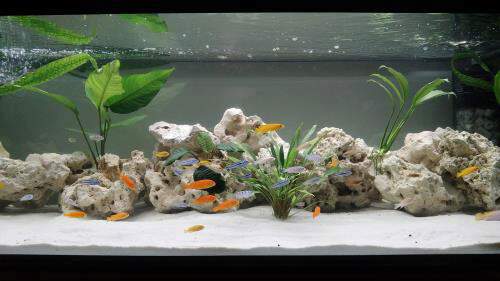How to Lower pH in Your Aquarium
How to Lower pH in Your Aquarium
Maintaining the correct pH level is crucial for the health and well-being of your aquarium inhabitants.
Understanding pH
pH is measured on a scale from 0 to 14.
Why Lower pH?
Many fish species, especially those from blackwater rivers or soft water regions, require acidic water. A higher pH can lead to:
- Stress: High pH levels can cause fish to become stressed, leading to reduced appetite and increased susceptibility to disease.
- Gill irritation: Prolonged exposure to high pH can irritate fish gills, making it difficult for them to breathe.
- Reduced nutrient availability: High pH can reduce the availability of essential nutrients for plants and fish.
Natural Methods to Lower pH
- Driftwood: Driftwood releases tannins into the water, which can lower pH and soften the water.
Popular choices include Indian Almond leaves, Catappa leaves, and Mopani wood. - Peat: Peat moss can be placed in a filter bag or used as a substrate to gradually lower pH and add beneficial tannins.
- Blackwater Extracts: Commercial blackwater extracts are concentrated solutions of tannins and humic acids, which can be added to your aquarium to lower pH and mimic natural blackwater conditions.
- Live Plants: Certain aquatic plants, such as Amazon swords and Java ferns, can help to lower pH by absorbing minerals from the water.
Chemical Methods
- pH Reducers: Commercial pH reducers can be used to quickly lower pH, but they should be used with caution and according to the manufacturer's instructions.
- Buffer Solutions: Buffer solutions help to stabilize pH levels and prevent sudden fluctuations.
Maintaining a Stable pH
- Regular Testing: Use a reliable pH test kit to monitor your aquarium's pH levels regularly.
- Water Changes: Regular water changes with pH-balanced water can help to maintain a stable pH.
- Filtration: A good filter can help to remove impurities and maintain water quality.
Tips for Lowering pH
- Start slowly: Make gradual changes to your aquarium's pH to allow your fish time to acclimate.
- Consider your fish species: Research the specific pH requirements of your fish before making any changes.
- Monitor water parameters: Keep an eye on other water parameters, such as hardness and alkalinity, as they can also affect pH.
Conclusion
Lowering pH in your aquarium can be achieved through a combination of natural and chemical methods. By carefully considering your fish species and following these guidelines, you can create a healthy and thriving aquarium environment.
Absolutely! Here's a response in English, combining the best aspects of previous responses and addressing any potential issues:
FAQ: Lowering pH in Your Aquarium
General Questions
- Why is pH important in an aquarium? pH is a measure of how acidic or basic the water is.
Different fish species have specific pH requirements. An incorrect pH can stress fish, irritate their gills, and lead to health problems. - What are the benefits of lowering pH naturally? Natural methods, like using driftwood or peat, are often gentler on the aquarium ecosystem. They can also provide additional benefits, such as softening water and releasing beneficial tannins.
- How can I stabilize pH levels in my aquarium? Regular water changes, a good filter, and using buffer solutions can help stabilize pH. Monitoring your aquarium regularly and making adjustments as needed is crucial.
Specific Methods
- Which plants help lower pH? Plants like Java moss, Hornwort, Amazon swords, and Java ferns can help reduce pH by absorbing minerals from the water.
- How should I choose driftwood for my aquarium? Look for woods like mangrove, oak, or almond that are known for releasing tannins.
Before adding it to your tank, thoroughly clean and boil the wood to remove any impurities. - Are chemical pH reducers safe? Chemical pH reducers can be effective but should be used with caution. Always follow the manufacturer's instructions and avoid overdosing.
- What happens if I lower pH too quickly? Rapid changes in pH can shock your fish.
Make gradual adjustments to allow your fish time to acclimate.
Troubleshooting
- What if my pH is too low? If your pH is too low, you may need to increase it by using alkaline substances or reducing the amount of acidic materials in your tank.
- Why is my pH fluctuating? Fluctuations in pH can be caused by factors such as overfeeding, decaying plant matter, or changes in water chemistry.
- How do I know if my fish are stressed due to pH levels? Signs of stress include rapid breathing, loss of appetite, clamped fins, and changes in behavior.
Additional Tips
- Test regularly: Use a reliable pH test kit to monitor your aquarium's pH levels.
- Consider water hardness: Hardness can influence pH. Soft water tends to be more acidic, while hard water is more alkaline.
- Consult an expert: If you're having trouble maintaining the correct pH levels, consult with an experienced aquarist or your local fish store.
By understanding the factors that influence pH and implementing the appropriate measures, you can create a healthy and thriving aquarium environment for your fish.
.jpg)





Comments
Post a Comment